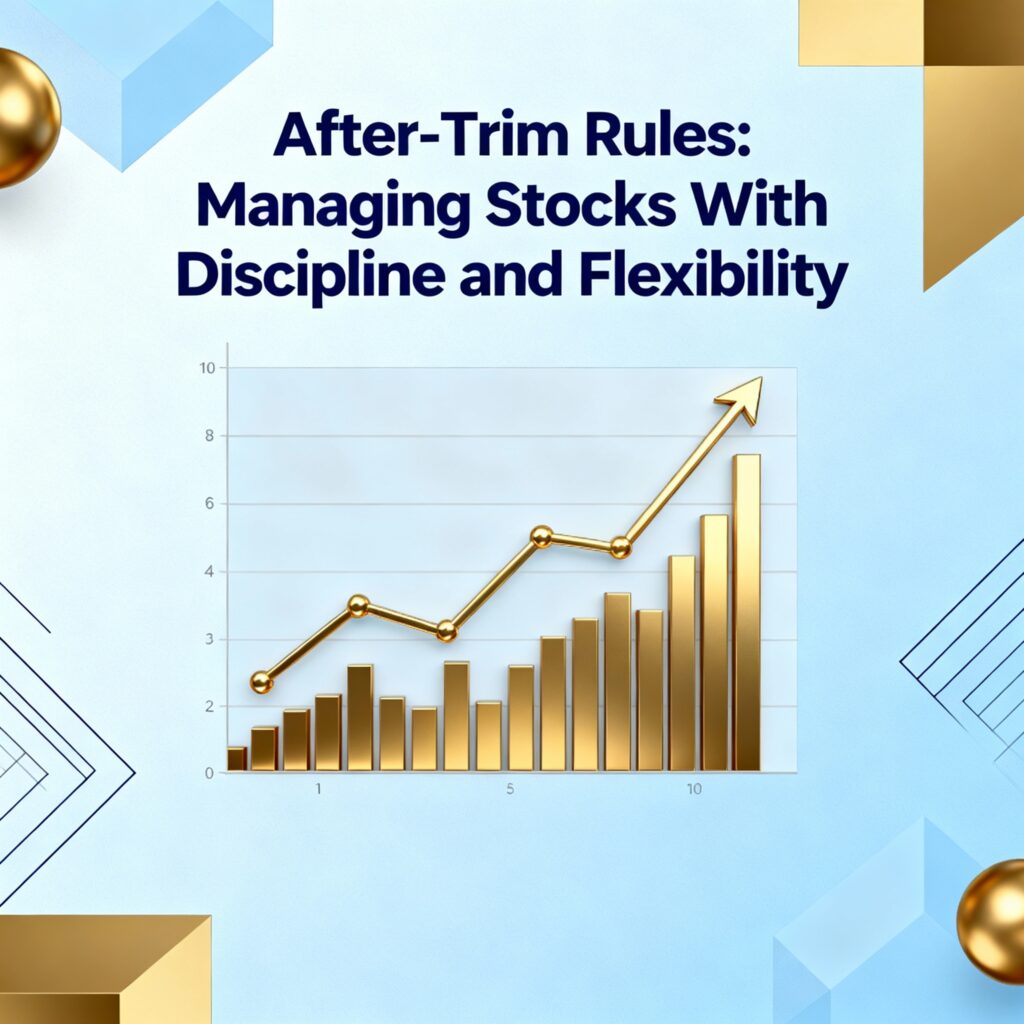I recently had some good fortune with a few moonshot stocks gaining between 40% and 100%. A common question arises: how do you lock in these gains without giving up too much potential upside too soon?
Trimming part of a winning position is one of the most effective tools to achieve this balance—locking in profits while staying invested for further upside. Here’s a practical set of rules and examples drawn from real trades:
1. First Sale: Capture Early Gains
- Sell about one-third of your position once a stock gains around 40–50% from your purchase price.
- Example – VNET: Bought at $7.00, first trim at $10.75 (about a 55% gain). This locks in profit while letting remaining shares run.
2. Second Sale / Rebuy Cycle
- If the stock doubles (around 80–100% gain) after your first trim, sell another one-third of the remaining position.
- Example – SLDP: Bought at $3.45, first trim at 51% gain ($5.22), locking in early profits. Second trim at $6.90 (~100% gain) realizes bigger returns.
- Rebuy Scenario: If you rebuy after the second trim and the price rises about 50% above your new average cost, set the next trim at a higher percentage relative to that cost.
- Tip: Calculate your new average cost by adding the total cost of remaining shares plus rebought shares, then dividing by the total shares held.
- This flexible approach adjusts to market conditions and encourages disciplined profit-taking instead of rigid rules.
3. Protecting Gains With Stops
After trimming, it’s crucial to protect remaining shares. Stops are a disciplined way to manage risk and lock in gains.
- Stop-Loss: A fixed price below your cost or last trim that triggers an automatic sale to limit losses.
- Example – VNET: After the first trim, a stop-loss was set at $8.50 to secure modest gains. When the stock dropped to $8.49, the stop-loss executed, ensuring remaining gains were protected.
- Trailing Stop-Loss: Moves up as the stock rises, automatically selling if it falls a set percentage from its peak.
- Example – SLDP: After trimming, a 20% trailing stop was applied. This allows remaining shares to capture further upside while protecting profits.
- Trailing Stop-Limit: Similar to a trailing stop but includes a limit price to avoid selling too far below your stop in volatile markets. Useful for controlled execution during fast-moving price swings.
4. High-Conviction Stocks: Flexibility
- You can rebuy after a trim if conviction remains high.
- Example – CRNX: After trimming portions around $44 and $46, additional shares were staged to buy on temporary dips at $40 and $38. Each subsequent trim after a rebuy acts as the “first trim” for that new position, following the same principles to protect gains and let winners run.
Visual Flow of the Strategy:
Stock rises 40–50%
First Trim (sell 1/3)
Set/adjust Stop-Loss / Trailing Stop on remaining shares
Trailing Stop triggers → gains/loss secured
Second Trim (sell 1/3)
Set/adjust Stop-Loss / Trailing Stop on remaining shares
Trailing Stop / Stop-Loss triggers → gains secured
The Foundations Behind These Rules
The trimming and stop strategies outlined here are grounded in time-tested trading principles that many successful investors rely on to manage risk and optimize profits. While these concepts are not new, the strength of this approach lies in applying them with disciplined flexibility and adapting to market conditions.
Here’s why these rules are both well-founded and practical:
- Trimming Winners Gradually: Selling part of a winning position as it gains locks in profits steadily, reducing risk of loss on the full position. This partial exit method is a widely recognized way to balance profit-taking with upside participation.
- Using Stop-Loss and Trailing Stops: These tools are core to disciplined trading, helping limit losses while allowing winners room to grow. Trailing stops, in particular, adjust exit points dynamically with price appreciation.
- Rebuying with New Average Cost Awareness: Entering more shares after trimming and dips lowers your average cost and increases potential upside, a savvy tactic for stocks you believe in strongly. Importantly, reapplying trimming rules to these new positions maintains risk management discipline.
- Flexible Guidelines Over Fixed Rules: Markets are dynamic, so rigid adherence to fixed percentages can hinder optimal decisions. This strategy promotes principled flexibility—adapting trim levels, stops, and rebuy targets to prevailing price trends and conviction levels.
By anchoring your trading actions in these fundamentals, you cultivate financial discipline, objective decision-making, and emotional control, all critical skills for long-term success in investing.
Key Takeaways
- Trim winners early to lock in profits.
- Protect remaining shares with stop-loss or trailing stops.
- Treat trims after a rebuy as new first trims, adjusting percentages based on new average cost.
- Stage additions only when you have high conviction.
- Avoid emotional trading—set clear guidelines but allow flexibility for exceptional opportunities.
- Learning to wait, adjust stops, and rebuy cultivates discipline, risk management, and emotional control.

